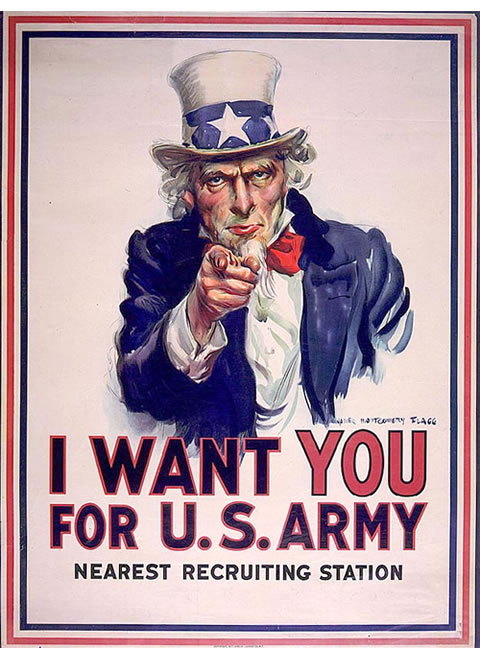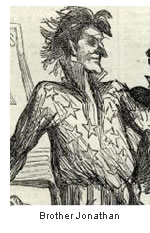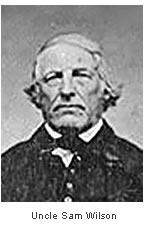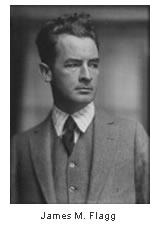
Mascots. You gotta love ‘em. They can make an intimidating team seem cuddly (Miami and its adorable dolphins), turn losers into lovable underdogs (Chicago Cubbies, anyone?), or make backwater minor-leaguers memorable (we’ve never seen the Montgomery Biscuits play, but we’re fans on principle). So it’s no wonder that countries capitalize on the phenomenon with mascots of their own. England has its bulldog, France has a beautiful warrior woman, and America … well, America has a New York meat packer. But you know him better as wacky, stilt-legged Uncle Sam. Allow us to explain. Sam’s Club  Arguably America’s most famous eccentric relative, Uncle Sam is a fairly recent addition to our national consciousness. But that’s not to say the United States didn’t have its fair share of political personifications before Sam came along. Lady Liberty was one of the earliest. Usually depicted draped in a toga and donning an elaborate headdress, she represented the blending of classical ideals and new world spirit. Another early mascot, Brother Jonathan, served as the face of the common man. Appearing in countless political cartoons, plays, and novels, his character applied homespun wisdom, acerbic wit, and a generous dose of orneriness to both political issues and pop culture. Arguably America’s most famous eccentric relative, Uncle Sam is a fairly recent addition to our national consciousness. But that’s not to say the United States didn’t have its fair share of political personifications before Sam came along. Lady Liberty was one of the earliest. Usually depicted draped in a toga and donning an elaborate headdress, she represented the blending of classical ideals and new world spirit. Another early mascot, Brother Jonathan, served as the face of the common man. Appearing in countless political cartoons, plays, and novels, his character applied homespun wisdom, acerbic wit, and a generous dose of orneriness to both political issues and pop culture.
 Then came Uncle Sam, the famous face of U.S. Army recruitment campaigns. And fittingly, he’s an icon born out of a military contract. During the War of 1812, a meat packer from Troy, N.Y., named Samuel Winslow won the right to supply beef to the American troops. Wilson (apparently more genial than your average butcher-slash-military contractor) was known to his neighbors as Uncle Sam. So when soldiers from the Troy area started spotting barrels of meat stamped with the initial “U.S.” they joked that the letters stood for Uncle Sam, rather than United States. Before long, even civilians were saying that “Uncle Sam was feeding the troops.” The phrase became common, and Sam-as-symbol made his debut in a 1838 political cartoon alongside Brother Jonathan. But, with his red stocking cap and conspicuously whisker-free face, ol’ “U.S.” didn’t look much like the poster-boy we know today. Then came Uncle Sam, the famous face of U.S. Army recruitment campaigns. And fittingly, he’s an icon born out of a military contract. During the War of 1812, a meat packer from Troy, N.Y., named Samuel Winslow won the right to supply beef to the American troops. Wilson (apparently more genial than your average butcher-slash-military contractor) was known to his neighbors as Uncle Sam. So when soldiers from the Troy area started spotting barrels of meat stamped with the initial “U.S.” they joked that the letters stood for Uncle Sam, rather than United States. Before long, even civilians were saying that “Uncle Sam was feeding the troops.” The phrase became common, and Sam-as-symbol made his debut in a 1838 political cartoon alongside Brother Jonathan. But, with his red stocking cap and conspicuously whisker-free face, ol’ “U.S.” didn’t look much like the poster-boy we know today.
Earning His Stripes (and Stars) By the time the Civil War started, Uncle Sam had become representative of a united federal government. That meant he had more resonance in the Union than Brother Jonathan, who’d become more associated with individualism. Consequently, when the north won, so did Sam. In fact, over the course of the next two decades, Jonathan virtually disappeared from newspapers’ editorial pages. With Uncle Sam’s new political symbolism came a new look. The nation desperate for leadership, he began to take on the characteristics of another famous icon, Abraham Lincoln. Interestingly, this transformation is widely credited to 19th-century illustrator Thomas Nast, who’s also responsible for our jolly, fat, red-suited image of Santa Claus as well as the use of donkey and elephant as political party symbols.  But Sam still had one last (extreme) makeover ahead of him. That came during World War I, when artist James Montgomery Flagg designated the famous “I want YOU” recruitment posters for the U.S. Army. In the process, he gave Uncle Sam a new face with a stern expression. That signature mug, ironically was made in Flagg’s own image. In order to save the hassle and expense of hiring a model, Flagg decided to paint a self-portrait. The result was a national icon that’s truly a cross-section of America – incorporating the face of an artist, the style of a president, and the name of a New York meat packer. But Sam still had one last (extreme) makeover ahead of him. That came during World War I, when artist James Montgomery Flagg designated the famous “I want YOU” recruitment posters for the U.S. Army. In the process, he gave Uncle Sam a new face with a stern expression. That signature mug, ironically was made in Flagg’s own image. In order to save the hassle and expense of hiring a model, Flagg decided to paint a self-portrait. The result was a national icon that’s truly a cross-section of America – incorporating the face of an artist, the style of a president, and the name of a New York meat packer.
______ This article was written by Mark S. Longo for the July-August 2005 issue of mental_floss magazine, and is featured in Neatorama in partnership with mental_floss. Be sure to visit mentalfloss.com for more cool stuff! 
Related links: Historical images of Uncle Sam | Brother Jonathan's images | Samuel Wilson [wiki], the original "Uncle Sam" | James M. Flagg [wiki] |


 Arguably America’s most famous eccentric relative, Uncle Sam is a fairly recent addition to our national consciousness. But that’s not to say the United States didn’t have its fair share of political personifications before Sam came along. Lady Liberty was one of the earliest. Usually depicted draped in a toga and donning an elaborate headdress, she represented the blending of classical ideals and new world spirit. Another early mascot, Brother Jonathan, served as the face of the common man. Appearing in countless political cartoons, plays, and novels, his character applied homespun wisdom, acerbic wit, and a generous dose of orneriness to both political issues and pop culture.
Arguably America’s most famous eccentric relative, Uncle Sam is a fairly recent addition to our national consciousness. But that’s not to say the United States didn’t have its fair share of political personifications before Sam came along. Lady Liberty was one of the earliest. Usually depicted draped in a toga and donning an elaborate headdress, she represented the blending of classical ideals and new world spirit. Another early mascot, Brother Jonathan, served as the face of the common man. Appearing in countless political cartoons, plays, and novels, his character applied homespun wisdom, acerbic wit, and a generous dose of orneriness to both political issues and pop culture. Then came Uncle Sam, the famous face of U.S. Army recruitment campaigns. And fittingly, he’s an icon born out of a military contract. During the War of 1812, a meat packer from Troy, N.Y., named Samuel Winslow won the right to supply beef to the American troops. Wilson (apparently more genial than your average butcher-slash-military contractor) was known to his neighbors as Uncle Sam. So when soldiers from the Troy area started spotting barrels of meat stamped with the initial “U.S.” they joked that the letters stood for Uncle Sam, rather than United States. Before long, even civilians were saying that “Uncle Sam was feeding the troops.” The phrase became common, and Sam-as-symbol made his debut in a 1838 political cartoon alongside Brother Jonathan. But, with his red stocking cap and conspicuously whisker-free face, ol’ “U.S.” didn’t look much like the poster-boy we know today.
Then came Uncle Sam, the famous face of U.S. Army recruitment campaigns. And fittingly, he’s an icon born out of a military contract. During the War of 1812, a meat packer from Troy, N.Y., named Samuel Winslow won the right to supply beef to the American troops. Wilson (apparently more genial than your average butcher-slash-military contractor) was known to his neighbors as Uncle Sam. So when soldiers from the Troy area started spotting barrels of meat stamped with the initial “U.S.” they joked that the letters stood for Uncle Sam, rather than United States. Before long, even civilians were saying that “Uncle Sam was feeding the troops.” The phrase became common, and Sam-as-symbol made his debut in a 1838 political cartoon alongside Brother Jonathan. But, with his red stocking cap and conspicuously whisker-free face, ol’ “U.S.” didn’t look much like the poster-boy we know today. But Sam still had one last (extreme) makeover ahead of him. That came during World War I, when artist James Montgomery Flagg designated the famous “I want YOU” recruitment posters for the U.S. Army. In the process, he gave Uncle Sam a new face with a stern expression. That signature mug, ironically was made in Flagg’s own image. In order to save the hassle and expense of hiring a model, Flagg decided to paint a self-portrait. The result was a national icon that’s truly a cross-section of America – incorporating the face of an artist, the style of a president, and the name of a New York meat packer.
But Sam still had one last (extreme) makeover ahead of him. That came during World War I, when artist James Montgomery Flagg designated the famous “I want YOU” recruitment posters for the U.S. Army. In the process, he gave Uncle Sam a new face with a stern expression. That signature mug, ironically was made in Flagg’s own image. In order to save the hassle and expense of hiring a model, Flagg decided to paint a self-portrait. The result was a national icon that’s truly a cross-section of America – incorporating the face of an artist, the style of a president, and the name of a New York meat packer.





"By the time the Civil War started, Uncle Sam had become representative of a UNTIED ([caps are mine for effect] federal government."
the editor/english teacher in me always notices ridiculous things like this...
http://en.wikipedia.org/wiki/John_Bull